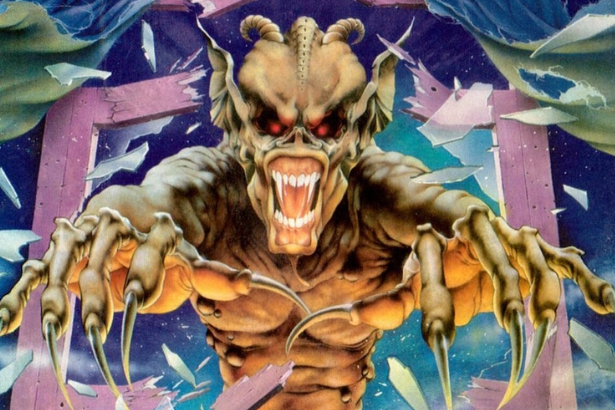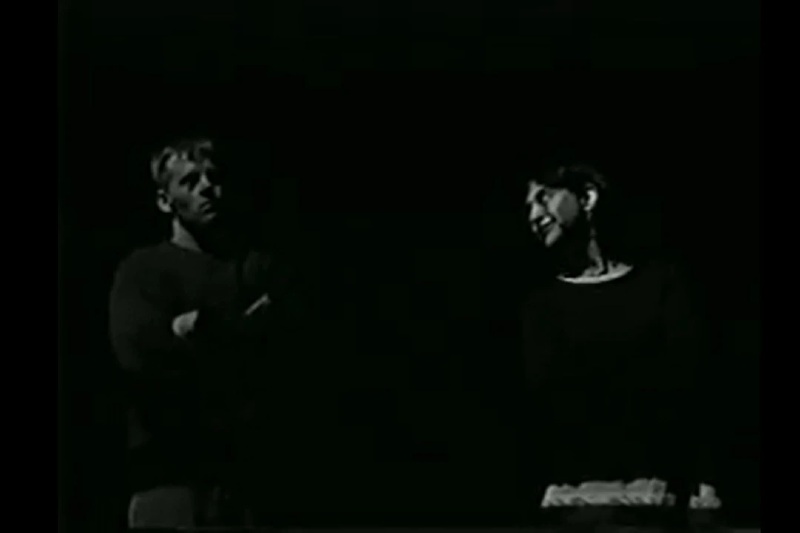The film that became Sorority House Massacre II was actually created on a whim. At least, so claims director Jim Wynorski in Maitland McDonagh’s 1995 book, Filmmaking on the Fringe. In 1990, Wynorski co-wrote the 78-page script in three days — and shot the film in seven — with the working title Jim Wynorski’s House of Babes. Other titles considered were The Seance and Nightie Nightmare, before the decision was made to release it as a “sequel” to Sorority House Massacre (1986) instead.
Two Films, One Story
Like a lot of Wynorski’s other one-week (or less) wonders, the film needed some pre-existing footage in order to stretch out the running time to feature length. Even though this latest film hadn’t been conceived or shot as a sequel to Sorority House Massacre, it made sense with the title change to try and source this footage with scenes from the original. There was just one problem. Producer Roger Corman wasn’t sure if Warner Brothers still held the rights to Sorority House Massacre. Because of this, Wynorski decided to instead turn to another Corman production he knew for sure he had full legal access to — the original The Slumber Party Massacre (1982).
Without intending to, the inclusion of this footage makes Sorority House Massacre II a fascinating companion piece to Slumber Party Massacre’s actual sequel, Slumber Party Massacre II (1987). Together they provide us with one of the most entertaining examinations of how two filmmakers — one male, one female — take on material seemingly inspired by the same source.
As written and directed by Deborah Brock, Slumber Party Massacre II is one of the most interesting and misunderstood films to come out of the original ‘80s slasher cycle. Inspired by the surrealism of Luis Buñuel, the film leaves it up to the viewer to decide if what we see is entirely a PTSD-inspired nightmare or a real-world experience in which those nightmares inexplicably manifest. From the beginning to the end, Brock leaves no doubt that everything we see is how her final girl Courtney sees it. This makes the film one of the only pre-Scream slashers to tell its story via an entirely female frame of reference.
Anyone familiar with the films of Jim Wynorski would immediately howl at the idea of his attempting to do the same thing. When given the freedom to film whatever he wanted, Wynorski made movies about large breasted women in as little clothing as possible.
A Difference in Directors
Many of Wynorski’s visions go out of their way to avoid being taken seriously, which worked well for early efforts like Chopping Mall (1986). But when he attempted a straightforward genre film like the Poe-inspired The Haunting of Morella (1990), it proved that his previous self-awareness was more a crutch to hide weaknesses than a deliberate authorial touch. After The Haunting of Morella exposed his inability to be a serious filmmaker, he decided to make Sorority House Massacre II his most overtly “Wynorski” film to date, leaning as hard as he could into all of the elements people now most commonly associate with his work.
Slumber Party Massacre II was Brock’s first film, and while parts of it do play like an ambitious student effort, it's the kind of movie that gets better with each subsequent viewing — especially after you’ve fully grasped its deliberate dream logic. Combining winking evocations of slasher cliches and outré touches like the film’s guitar-drill wielding maniac having his own musical number, Brock’s attempts at self-parody do a much better job of serving her strengths rather than disguising her failures.
In both films, we’re shown/told that the final girl from Slumber Party Massacre is now in a mental institution. In Brock’s film, her younger sister is the lead character. She’s presented as a normal teenage girl who plays guitar in a band and has a crush on a handsome acquaintance she’s considering having sex with. In Wynorski’s film, the younger sister is a topless dancer in a strip club scene, only inserted into the script because Corman made a lot of money on Stripped to Kill.
This sexualization is the most obvious difference between the films. Brock has only one of her characters appear topless and a joke is made about how gratuitous this is. When she shows Courtney sleeping, star Crystal Bernard is wearing a comfortable nightgown that reminds us of her character’s young age. Meanwhile, Wynorski has all but one of his eight female cast members take off their tops and they spend the bulk of the film dressed in transparent lingerie. In a hilarious touch, the innocence of the film’s final girl is established by the fact that she walks around in regular panties instead of the thongs her friends wear.
But, for me, the key difference comes in how the two of them treat their final girl. To Brock, Courtney is a tragic figure who insists she isn’t tormented by her past experience, but whose nightmares prove this to be a lie.
Final Girl Psychology
Because of what happened to her, Courtney now associates the idea of her first sexual experience with being murdered. But there is as much attraction as fear in her penetration anxiety, which is why she imagines (or does she?) her tormentor as a handsome rockabilly musician instead of the ordinary middle-aged man who caused her trauma. She desires his attention as much as she fears it and this inability to separate her growing interest in sex with her prior victimization is what causes her eventual breakdown.
The film ends with the image of a screaming Courtney, in the same room and nightgown as her institutionalized sister, as a drill comes through the floor. Has she been here the whole movie? Is this where the events we’d just seen led her? Brock leaves this up to us, but the overall feeling is that no matter which is true, Courtney was never going to be able to escape what happened to her — it was simply too horrific for her to bear.
The care and empathy that Brock shows for Courtney is counteracted by the total lack of interest Wynorski has in his final girl, Linda (Gail Thackray credited as Robyn Harris). Her status as the FG is indicated by her being the easiest to scare and — as previously mentioned — her slightly less sexy underwear. When it comes time for her to show off her prowess, it’s only as a means to pay off a sick joke.
In a twist that recalls the ending of William Fruet’s Killer Party (1986), it turns out that the killer wasn’t Orville Ketchem, the creepy dude who’d been hanging around the sorority house, but instead Linda’s friend Jessica, who’s possessed by the killer we saw in the Slumber Party Massacre flashbacks. When Linda kills Jessica, the killer’s spirit moves into her and Orville saves the day by pumping our heroine full of bullets.
It seems likely that Wynorski considered this his own funny inversion of the final girl cliche. Instead of having Linda defeat the killer, she becomes the villain who is heroically killed by the creepy guy who we’ve seen make the girls uncomfortable throughout the film. But rather than feeling clever, this twist just comes off as cruel and mean-spirited. The film’s otherwise light and comedic tone ends up amplifying an overall sense of misogyny that pairs poorly with the unapologetic objectification of its characters.
Horror Repeats Itself
But there’s a chance that Wynorski recognized this himself — he made Hard to Die that same year. Corman put the more overtly-comedic remake of Sorority House Massacre II into production after deciding he wanted a version of the film he owned outright without any legal complication. With this second chance to tell the same story, Wynorski apparently rethought his original ending and found a way to wrap up the narrative that both honored his obvious affection for Ketchem and allowed his final girl to survive.
Featuring much of the same cast (and — once again — flashback footage from The Slumber Party Massacre), Hard to Die moved the action from a sorority building to a lingerie shop (of course), among other nominal changes. The biggest revision (beyond switching the gratuitous scene at the strip club to a gratuitous scene at a porn shoot) comes when Thackray avoids possession at the end and is saved by Ketchem. The film wraps up with the two of them reaching out to hold hands as they’re both taken to the hospital on stretchers. “The End” appears on screen, surrounded by a heart to really drive home that this is the beginning of a new relationship.
Watching the two films back to back really does make it feel like an acknowledgement that the original ending was a mistake. While it’s possible that Wynorski made this change simply to avoid repeating himself, it manages to both square with Hard to Die’s tone while avoiding Sorority House Massacre II’s smug mockery of the slasher genre’s most redemptive trope.
It’s to Roger Corman’s credit that he frequently gave filmmakers the chance to experiment like this — so long as they stayed within their tiny budgets. Despite their unintended connection, comparing Sorority House Massacre II (and Hard to Die) to Slumber Party Massacre II reveals how dramatically two filmmakers working in the same environment with the same producer — but with different life experiences — can diverge telling very similar stories.
Conclusion
Seen together, these films highlight the inherent worth of pursuing diversity not just as a means to correct past inequities but also as a way to create more interesting and unique films that stand the test of time.
When Roger Corman gave Brock a chance to show what she could do, she played with the slasher formula in ways that audiences are only now starting to appreciate 35 years later. He may have ultimately made more money having Wynorski make the same movie twice, but her film is the one that is going to keep people talking, while Wynorski’s two efforts are much more likely to fade away in the distance.







